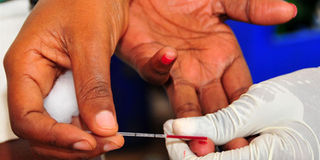Mbarara among 13 high HIV risk districts - research

A person undergoing an HIV test recently. Research has shown that Mbarara is among high HIV risk districts. Photo by Faiswal Kasirye.
What you need to know:
Young women around the age of 26 have been found to be the most affected.
Mbarara - Research conducted in three hotspots of Kijungu, Nyeihanga and Ruti in Mbarara shows that the HIV/Aids prevalence rate is at 12.6 per cent two times the general district prevalence rate.
The HIV prevalence rate in the district is at 6.1 per cent against the national prevalence of 7.3 per cent.
The hotspots are some of the busiest areas in the district that have many bars and lodges and are frequented by trans-boundary travellers.
Kizungu in Kakoba Division Mbarara Town has many bars and lodges that are frequented by sex workers, Ruti suburb in Nyamitanga Division is a station for truck drivers on long routes to DR Congo, Rwanda and Burundi.
Nyeihanga Trading Centre, located about 30 kilometres along Mbarara-Kabale road is frequented by local and international coffee, fish, sand and matooke traders.
The research was conducted by Makerere University School of Public Health and Mbarara District Local Government.
The findings were made public at Mbarara District Council Hall Kamukuzi on Thursday.
The study involved 245 respondents; 78, 87 and 80 in Kijungu, Ruti and Nyeihanga respectively.
The HIV/Aids prevalence was found at 13 per cent, 7.9 per cent and 15.8 per cent in Kijungu, Ruti and Nyeihanga respectively.
“There was a very high prevalence up to the level of 16 per cent in Nyeihanga, far beyond 6.1 per cent of the district. HIV is at 9 per cent among males and at 31 per cent among females, far beyond the national level of 6.1 for males and 8.2 for females,” Mr Umar Masereka, the Mbarara HIV/Aids Focal Person, said.
The research shows that there is high level of inconsistent use of condoms even when they are available in many shops.
“It was found that people don’t want to use condoms. These areas with high infection are associated with many bars,” Mr Masereka said.
The research was intended to provide the district local government with empirical data to ensure evidence-based planning, implementation and monitoring of HIV/Aids interventions.
Mr Masereka added: “We have specifically known areas to target. We have known behaviours of people who are infected. We are going to carry out more focused interventions.”
Dr Simon Kasasa, a lecturer at Makerere University School of Public Health, who was the chief researcher, said Mbarara District, being an urban centre, has a lot of commercial sex activities.
He added that its location on the neighbourhood of countries like DR Congo, Rwanda and Tanzania allows concentration of trade that in turn boosts activities that could lead to sex-related ones.
“We chose Mbarara because it is a cross road point to border districts and because of its urbanisation rate,” Dr Kasasa said.
According to the national stakeholder’s HIV risk scorecard that ranks districts according to their HIV risk in categories of High, Medium and Low, Mbarara is among the 13 high HIV risk districts.
The district health officer, Dr Amooti Kaguna, admitted that indeed empirical evidence supports the hypothesis they had.
Mbarara District hosts National Cerebrations for World Aids Day today. The function will be at Uganda Bible Institute Grounds in Nyamityobora Kakoba Division.




